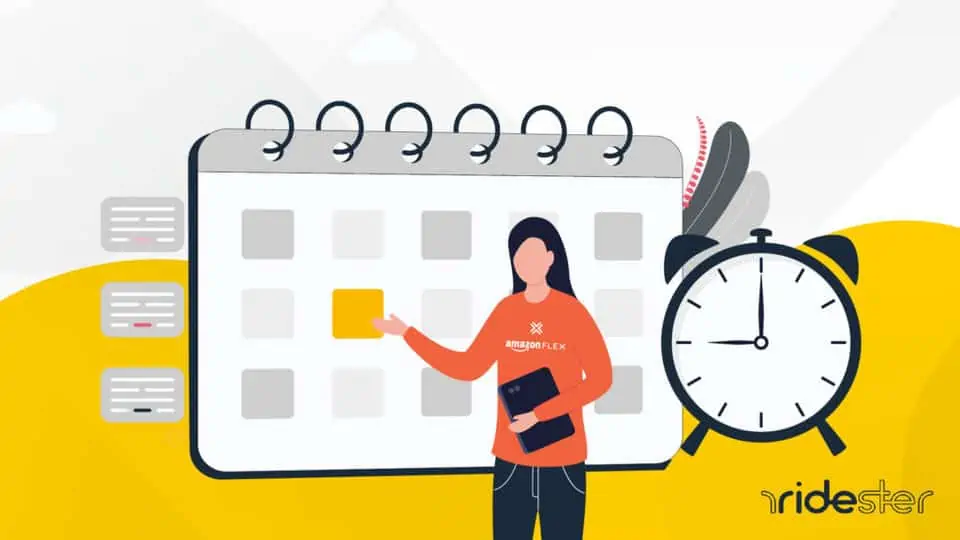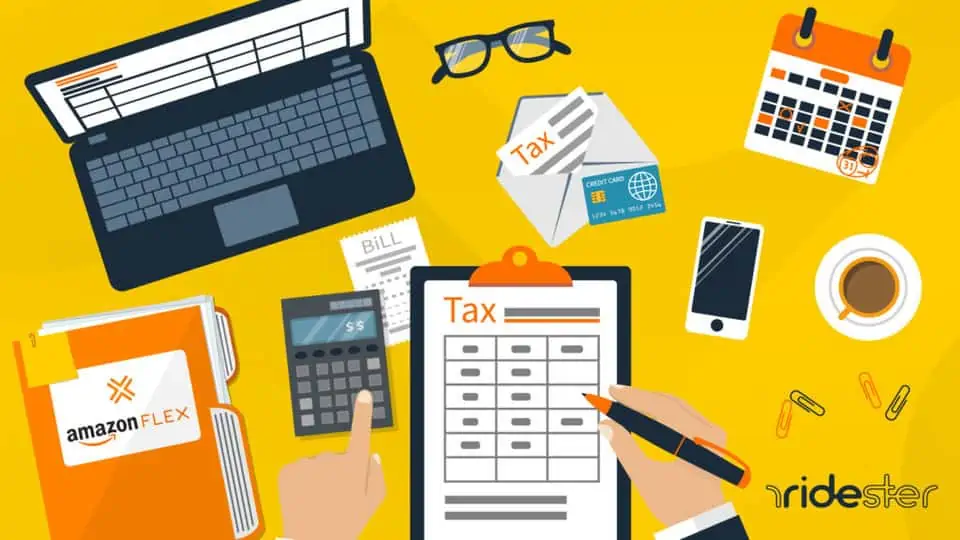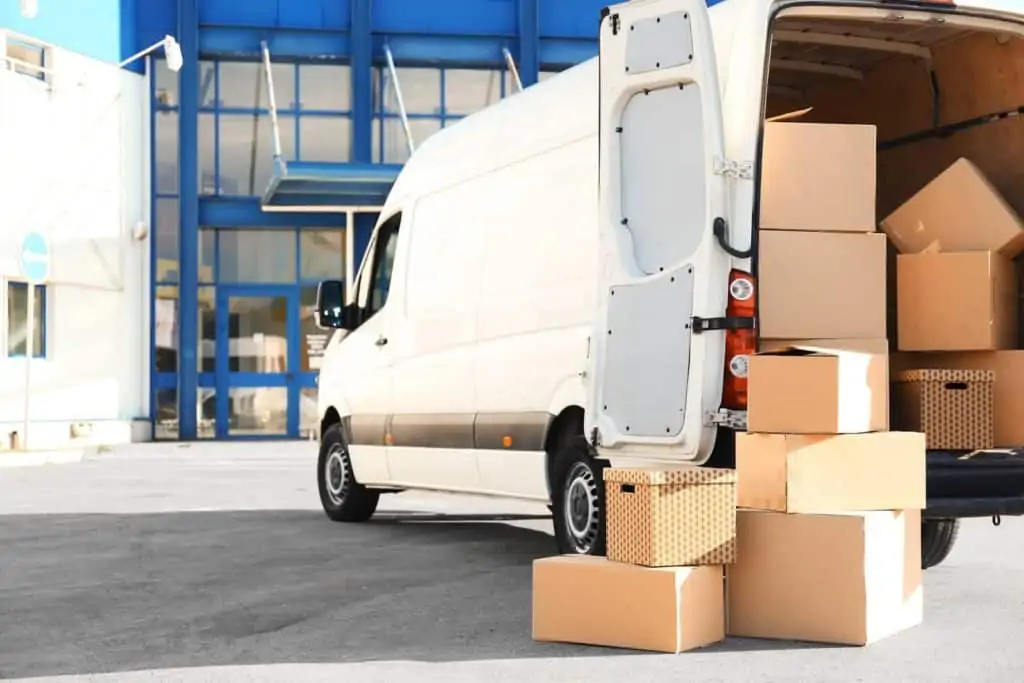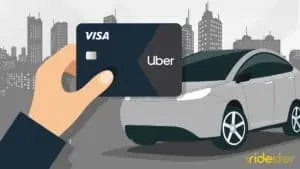Key Takeaways
- Flex drivers earn $18-$30/hour, depending on demand, weather, and holidays. Prime Now drivers can also earn tips.
- Drivers are capped at 7 hours/day, 29 hours/week, and 116 hours/30 days to maintain part-time status and avoid legal issues.
- Earnings vary based on the number of shifts and hours worked. Busy periods may offer more hours.
- Drivers know their earnings per block in advance, with most blocks ranging from 2-6 hours. Tips are additional for Prime Now deliveries.
- How Much Do Amazon Flex Drivers Make?
- Breaking Down the Amazon Flex Payment Structure
- Factors Influencing Amazon Flex Driver Earnings
- Common Expenses That Eat Into Amazon Flex Driver Pay
- Maximizing Earnings as an Amazon Flex Driver
- Challenges and Practical Considerations
- Frequently Asked Questions
- Earn Money With Local Deliveries
How Much Do Amazon Flex Drivers Make?
Amazon Flex drivers typically earn a base pay of $18 per hour, which can rise to as much as $30 per hour depending on factors like high demand, bad weather, or holiday rushes. Additionally, drivers delivering for Prime Now have the opportunity to earn tips.
The exact income varies based on the number of shifts worked and the hours Amazon allocates. Amazon sets caps to ensure part-time work: a maximum of 7 hours per day, 29 hours per week, and 116 hours every 30 days.
This cap is in place because Flex drivers are independent contractors, not Amazon employees, and Amazon wants to avoid legal issues that might arise if drivers consistently worked full-time hours. However, these caps can be lifted during busy periods like the winter holidays.
The key to maximizing income as an Amazon Flex driver is to secure more delivery blocks.
For a breakdown of what drivers can expect to earn, let’s turn to data from Solo’s Marketplace Insights. We’ve included 15 of the cities with the most active drivers and extracted the data:
| City | Average Hourly Pay (USD) | Tips per Hour | Best Days to Work |
|---|---|---|---|
| Seattle | 29.61 | 1.63 | Tuesday, Wednesday, Thursday |
| Los Angeles | 28.43 | 2.21 | Monday. Tuesday, Saturday |
| Tacoma-Olympia | 28.37 | 0.84 | Wednesday, Thursday, Saturday |
| Portland | 27.94 | 1.28 | Monday, Wednesday, Saturday |
| Raleigh | 27.01 | 1.00 | Sunday, Tuesday, Friday |
| Austin | 25.91 | 2.36 | Wednesday, Thursday, Saturday |
| Detroit | 25.53 | 0.10 | Sunday, Thursday, Friday |
| Cleveland | 25.21 | 0.78 | Sunday, Friday, Saturday |
| Charlotte | 24.88 | 0.59 | Sunday, Friday, Saturday |
| Chicago | 24.04 | 1.45 | Sunday, Monday, Thursday |
| Phoenix | 23.33 | 1.12 | Monday, Tuesday, Wednesday |
| Dallas | 22.63 | 1.92 | Sunday, Monday, Wednesday |
| Tampa | 21.47 | 0.27 | Sunday, Monday, Thursday |
| Miami | 21.13 | 0.29 | Tuesday, Wednesday, Friday |
| Indianapolis | 21.12 | 0.12 | Sunday, Monday, Friday |
What This Data Can Tell Us About Amazon Flex Earnings
When looking at the data above, it is clear that drivers in densely populated urban centers experience blocks with a higher frequency compared to those in suburban or rural locations where there is lower demand.
For example, in October, the average hourly pay in Los Angeles was $28.43. Meanwhile, the average hourly pay in Orlando was $19.88. The population size between the two cities is 3.8 million compared to 300 thousand.
By comparing these earnings with those from other gig economy delivery jobs, we can gain valuable insight into their worth.
Platforms such as DoorDash, Uber Eats, and Instacart all provide enticing self-employment opportunities with their own unique benefits. However, going by statistics alone, it looks like Amazon Flex is the clear winner!
For instance, take a look at Austin Texas: Flex drivers here earn an average hourly pay of $25.91.
When compared with DoorDash ($14.60), Lyft ($15.24), Instacart ($20.74), Spark ($17.21), and Uber Eats ($15.47), Flex clearly stands out amongst the competition. On the contrary, Uber ($24.18) and Shipt ($22.04) have Amazon Flex beat, edging out a bit more earnings per hour.
| Platform | Average Hourly Pay (USD) | Annual Earnings (USD) | Tips Opportunity |
|---|---|---|---|
| Amazon Flex | $25.91 | $44,720 | Yes |
| DoorDash | $14.60 | $30,368 | Yes |
| Uber Eats | $15.47 | $32,178 | Yes |
| Instacart | $20.74 | $43,139 | Yes |
| Shipt | $22.04 | $45,843 | Yes |
| Spark | $17.21 | $35,797 | Yes |
| Uber | $24.18 | $50,294 | Yes |
| Lyft | $15.24 | $31,699 | Yes |
It must be noted too that these figures are the base rate taken before tax and do not include any benefits, bonuses, tips, or additional incentives. You can more accurately find out the end average Flex pay rate by researching taxes as a contractor.
In the end, how much you earn is really up to you and how much you are willing to work! As such, it is important to consider all the factors I’ve mentioned above before jumping on this fantastic opportunity.
Related: How to get more Amazon Flex blocks
Understanding Real-World Earnings Scenarios
By looking at some real-world scenarios, you may be able to get a better idea of your earning potential.
For those looking to work in a bustling urban center like Seattle or Portland, expect to earn a lot more! These cities offer an average hourly rate of $29.61 and $27.94, respectively.
This is because package deliveries are in high demand and require you to travel shorter distances. If done strategically, workers here can choose short-duration blocks during peak hours for maximum efficiency.
In more suburban-based cities such as Indianapolis and Miami, expect to earn much less ($21.12 and $21.13 respectively). Although a lot lower than the Amazon Flex $25.91 average, you can maximize your earning potential by focusing on longer-duration blocks to combat the placement of fewer orders.
A tactical driver will leverage their bonuses and consider optimum travel routes to pull in higher profits.
These rates are variable too, as someone working in an area with a lower package demand can just as easily make the hourly rate of a densely populated city by working longer shifts on seasonal peaks or holidays.
If you tailor your approach and plan your working hours in advance, a decent wage is all but guaranteed.
In essence, the flexibility of the platform can be manipulated to work in your favor. It is up to you to personalize the experience to your needs and desires.
If you want to earn as much as you can, it is extremely important to strategize!
Breaking Down the Amazon Flex Payment Structure
Amazon Flex drivers are paid a flat sum for every shift — known as a delivery block — they accept and complete.
Most available blocks typically last between two and six hours from the time of your arrival to the pick-up location to the time of your final package drop-off.

Before you accept any delivery block, you’ll always see your guaranteed earnings as well as an estimate of how long it will take to complete the relevant deliveries. This way, you’ll be able to calculate how much you’ll earn per hour before you commit.
For example, if a two-hour block offers a $36 guarantee, you’ll know that you’ll earn $18 per hour once you complete your shift.
As long as all your packages are successfully delivered (or returned to a delivery station as needed), you’ll soon receive the exact earnings that were offered for your delivery block.
This makes Amazon Flex’s payment structure far more transparent than those of rideshare companies like Uber and Lyft, which take at least 20% commission from rides that are offered with unclear trip totals.
If you complete Prime Now deliveries, you’ll also get the chance to get customer tips on top of your guaranteed earnings. Delivery partners receive 100% of the tips customers provide.
Mileage reimbursement is not included in the payment structure for any Amazon Flex delivery blocks, so keep this in mind as you calculate your real earnings for each trip.
Factors Influencing Amazon Flex Driver Earnings
How much drivers make depends on a variety of factors. Pay will be influenced mostly by the length and types of Amazon Flex deliveries.
For example, longer blocks will often provide higher compensation. Additionally, you may earn bonuses for certain blocks that entail challenging or time-pressured deliveries.
The most common type of delivery for Flex is Amazon Logistics. This is where you deliver Prime, or traditional Amazon packages within three to six-hour blocks. Drivers earn the base rate and don’t often receive tips.
In contrast, Prime Now drivers make one to two-hour deliveries and receive tips on the regular.
This is because Amazon Prime members pay a premium fee for the express delivery, and the packages often include perishables and alcohol.
However, Prime Now deliveries are competitive and can be difficult to get. As such, it is important to think about getting more Flex blocks by learning the ins and outs of your delivery location.
Investigate when blocks are made available, research how the weather influences block availability, and claim open blocks as quickly as possible to increase your earning potential.
You must also think about special events such as Prime Day or Christmas and how they might influence the demand!
By planning your route and time efficiently, you could complete a lot of jobs and make a ton of money over the seasonal holiday periods.
For any driver wanting to maximize their earning potential, it is necessary to understand the strategy and dynamics of your local market.
Common Expenses That Eat Into Amazon Flex Driver Pay

Amazon Flex is a great way to make money on the side, but it’s not without its expenses.
And as an independent contractor, you do not receive reimbursement for any expenses you incur in the course of the job.
Therefore, you need to consider the following expenses carefully when figuring out if Amazon Flex is a worthwhile gig to pursue.
Because that $18 per hour sounds great on paper, but the reality can be a bit less when you factor in the following expenses:
1. Car payment
Do you outright own the vehicle you’re using to make Amazon Flex deliveries, or are you still making car payments to a lender?
If so, then you have to count these against whatever you’re making when figuring your final profit.
That being said, Amazon Flex can be a good strategy to supplement an existing car payment if you just work for the service a few hours a week on the side.
2. Vehicle maintenance
Making deliveries using your own vehicle will increase the mileage and overall wear and tear on the vehicle itself.
This means more frequent maintenance and a lower overall life span for your vehicle, which can cut into your earnings significantly.
3. Gas
Wherever you are, you’ve got to pay for gas (unless you’re making deliveries in an electric car or vehicle with another alternative fuel source).
All that extra driving means you’ll be going through extra gas as well, especially if you’re driving a less fuel-efficient vehicle such as a truck or van.
Make sure to understand how to save money on gas and you’ll be fine.
4. Insurance
Legally, you have to have insurance for your vehicle whether or not you use it for making Amazon Flex deliveries.
But still, since you’re using your vehicle for business purposes, that means your auto insurance is now a business expense.
5. Vehicle registration
In the same vein as insurance, you have to have proper vehicle registration regardless, but it’s still something you can consider as a business expense.
6. Taxes
This is where your profits really start to shrink.
Because you’re an independent contractor, Amazon doesn’t withhold any taxes on the money they pay.
That’s your responsibility now, so check out our guide to self-employment taxes to ensure you’re not in for a nasty surprise at tax time.
It’s impossible to give exact numbers for the above expenses, as they will vary based on where you live, what you drive and your age.
Luckily, most job-related expenses are tax-deductible, so as long as you keep track of your mileage and spending, you can save quite a bit of money once tax season rolls around.
Your accountant can give you further guidance on which exact expenses qualify.
Maximizing Earnings as an Amazon Flex Driver
To get the most out of the Amazon Flex experience, there are multiple tactics you can employ:
1. Smart Block Selection
Think about what delivery blocks are in popular locations and are considered to have peak demand.
Feel free to experiment with various block durations to find a healthy balance between your pay rate and the time you have committed.
2. Route Optimization
Do you know shortcuts? Have you considered what roads have a high concentration of traffic at certain times of day?
If you minimize your idle time between deliveries, you will inevitably be fulfilling more frequent orders.
3. Time Management
The name of the game is speed and precision.
If you efficiently manage your time allocated for each block, quick and accurate deliveries will not only earn you the big bucks, but positive customer feedback could contribute to bonuses and further incentives.
4. Utilize Amazon Flex Features
The Flex app is your new best friend! With a plethora of opportunities to save through cashback and retail discount incentives, your pay will not simply be restricted to how much you earn per hour.
5. Stay Updated
Keep on top of announcements, promotions, and updates from the Amazon team!
They love to throw in various bonuses and incentives for their drivers from time to time. It may be a good idea to join a few of the many driver-run Facebook pages or WhatsApp groups to share strategies and learn about upcoming promotions.
Challenges and Practical Considerations
Like all delivery services, Amazon Flex comes with its challenges. It is important to learn what these are now so you can combat them in the future:
1. Vehicle Maintenance Costs
Wear and tear of your vehicle is not covered by Amazon. It is necessary to set aside some of your earnings to conduct regular maintenance and repairs on your mobile office.
2. Fluctuating Work Availability
Blocks are subject to demand fluctuations and must therefore be anticipated!
Managing your expectations is super important when planning for variability in your upcoming workload.
3. Competition for Blocks
As it has a higher earning potential than its delivery competitors, it is only natural that there will be a higher demand for work within Amazon Flex itself.
Develop your own strategy for block selection and stay vigilant for new opportunities.
4. Tax Management
As you’re self-employed, you are responsible for your own taxes.
Make sure that you set aside some of your earnings to cover the costs of your taxes and possibly an accountant. You can find a lot of helpful information on taxes as a contractor online!
5. Insurance Coverage
The worst thing that could happen is that you get into an accident and you can’t cover the costs of a new vehicle.
That’s why it’s important to insure your car with more than just standard auto insurance! There are multiple options for insurance tailored to work with gig economy employees, and again, these can also be found online.
Frequently Asked Questions

How does Amazon Flex driver pay compare with food delivery driver pay?
Amazon Flex pays its contractors quite well, compared to food delivery services and similar companies in the gig economy.
Delivery drivers for brands like Postmates and DoorDash often make less than minimum wage, at least before tips, due to the fact that they aren’t guaranteed to get any requests when they’re driving around.
How Are Amazon Flex Drivers Paid?
Amazon Flex drivers receive payments twice weekly via direct deposit, typically within one business day after processing on Tuesdays and Fridays. Customer tips are added within a few days of delivery completion.
Drivers can update their bank details in the Amazon Flex app and contact support for any issues.
Does Amazon Flex Pay for Gas?
No, Amazon Flex does not pay for gas. However, drivers can earn cash back on all fuel and eligible EV charging purchases through the Amazon Flex Rewards program.
Does Amazon Flex Pay Same Day?
Yes, self-employed drivers can choose to get paid every day or on a day of their choice. You can pick what days are best for you and change them whenever you want. Blocks completed on Friday, however, will be paid out the following Monday.
Earn Money With Local Deliveries
Becoming your own boss is easy when you sign up for Amazon Flex — and the pay isn’t anything to complain about either.
The e-commerce company pays its delivery drivers more than the average gig economy company, ensuring you’ll always make more than minimum wage.
Though there are expenses that come with driving for Amazon Flex, this is only to be expected with an independent contractor career.
If you love the idea of driving your own vehicle around the city to earn but don’t need the flexibility of an independent contractor gig, a part-time or full-time job may be worth your time.
Learn how you can make money through package deliveries as a UPS Personal Vehicle Driver as an alternative to the Amazon Flex gig.






Detroit Flex here.
The LEAST they pay is $22/hour, still too low.
Climbing to $25 is not correct. I do not accept a block for less than $28. Some of my most recent ones have been $32, & the most was around $35. If I recall correctly.
It is actually dangerous work. I do the 330 to 430am m-f start to try to avoid traffic. Ive run off the road & needed a tow, had idiots come out with their dogs barking, growling, & a “Can I help you???”, & I have had the POLICE called on me multiple times.
Now keep in mind, I am wearing an Amazon Flex vest, have a car full of obvious packages, & am a White middle-aged Female.